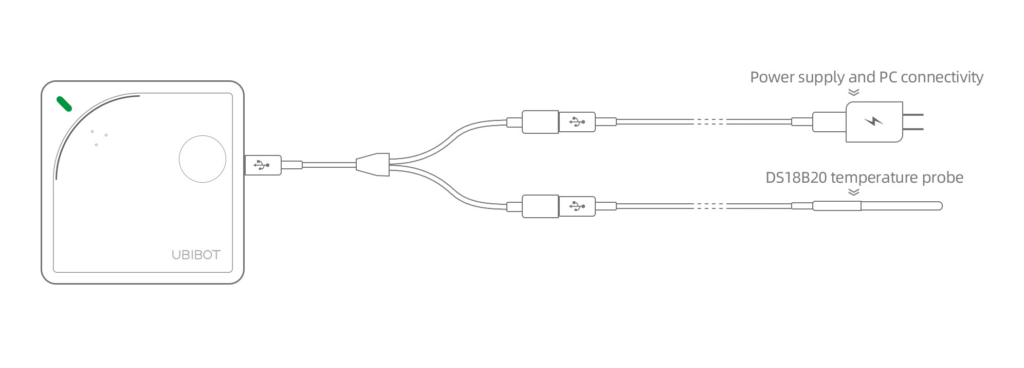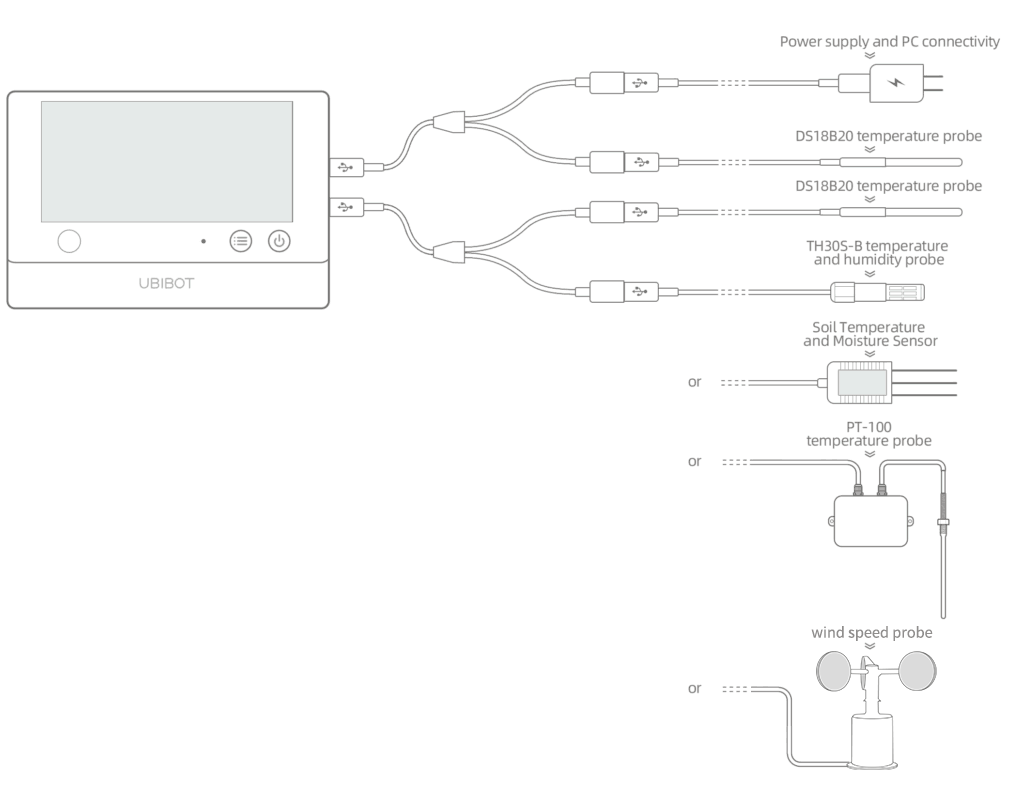
Instructions of Ubibot Probes Connection
2019-08-30 10:26:25
Ubibot insists on researching and developing self-owned patent products, including the external probes that match our sensing devices.
Different types of probes can match with different device. Here are the instructions of how to use them.
Using WS1 device:
This device supports DS18B20 probe. As it only has one USB port, only one probe can be connected. When using USB power at the same time, one USB splitter is needed. Connect the splitter to the device USB port, one female port is for power and the other is for data transmission.

Using WS1 Pro device:
This device supports DS18B20, TH30s-B, Soil temperature and moisture sensor, PT-100 extreme temperature probe, and wind speed probe.
It has two USB ports, of which the lower one is embedded with RS485 interface. Except the DS18B20 probe, the others both need to be connected to this lower USB port. While, you can use DS18B20 on either of the USB port. When you need to power the device via Micro USB and you want to connect more than two probes at the same time, please remember, the ends of the splitter must be connected with one power supply and one probe, or one DS18B20 and one RS485 probe. Two same probes are not supported on one port.

Using GS1 device:
The GS1 device is built with RS485 interface and audio jack. It supports all of the 6 types of Ubibot probes, such as TH30S-B temperature humidity probe, Soil moisture probe, PT-100 temperature probe, CO2 probe, wind speed probe, external light probe.
If you only need one type probe, you can connect it to the device directly. If you need more than one type, our splitters will allow you to attach multiple probes simultaneously. Please see the following cutline for reference.
Please note, only one piece of probe of each type is supported. You can not attach two or more of the same probes at a time. For details, please contact us for specific instructions.

*Please note, the probes are under one year limited warranty since the purchase date. For details, please click here.
Different types of probes can match with different device. Here are the instructions of how to use them.
Using WS1 device:
This device supports DS18B20 probe. As it only has one USB port, only one probe can be connected. When using USB power at the same time, one USB splitter is needed. Connect the splitter to the device USB port, one female port is for power and the other is for data transmission.

Using WS1 Pro device:
This device supports DS18B20, TH30s-B, Soil temperature and moisture sensor, PT-100 extreme temperature probe, and wind speed probe.
It has two USB ports, of which the lower one is embedded with RS485 interface. Except the DS18B20 probe, the others both need to be connected to this lower USB port. While, you can use DS18B20 on either of the USB port. When you need to power the device via Micro USB and you want to connect more than two probes at the same time, please remember, the ends of the splitter must be connected with one power supply and one probe, or one DS18B20 and one RS485 probe. Two same probes are not supported on one port.

Using GS1 device:
The GS1 device is built with RS485 interface and audio jack. It supports all of the 6 types of Ubibot probes, such as TH30S-B temperature humidity probe, Soil moisture probe, PT-100 temperature probe, CO2 probe, wind speed probe, external light probe.
If you only need one type probe, you can connect it to the device directly. If you need more than one type, our splitters will allow you to attach multiple probes simultaneously. Please see the following cutline for reference.
Please note, only one piece of probe of each type is supported. You can not attach two or more of the same probes at a time. For details, please contact us for specific instructions.

*Please note, the probes are under one year limited warranty since the purchase date. For details, please click here.